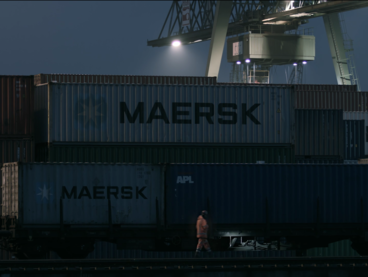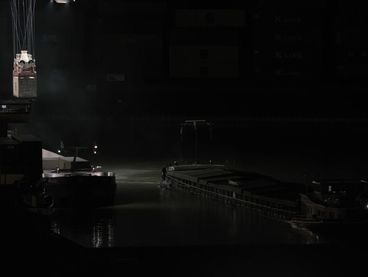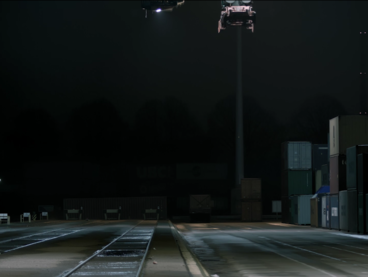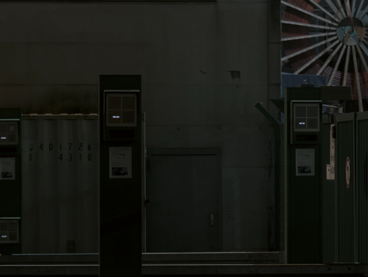MOOZ – audiovisual arts collection
monoscape
Concept and realization: Viktor Brim
DOP: Simon Baucks
Sound: Angelo Wemmje, Constantin Schädle, Sophie Salzer
Advisors: Prof. Matthias Müller, Daniel Burkhardt, Prof. Frank Döhmann
Viktor Brim’s art is about looking. What sounds profane and everyday is complicated upon closer inspection, as an attitude and position is inherent in every instance of seeing, a particular relationship to the object of consideration. Brim neither exaggerates nor devalues, neither mystifies nor analytically minimizes the landscapes, objects, and people that he turns his attention to. By exactly calculating the duration of his gaze and precisely cropping the image, he succeeds seemingly effortlessly in letting that which is viewed to speak for itself. And this true at the level of the past (through inscribed traces), the present (through the documented presence), as well as the future (through the suggested extrapolation of happenings that are only visible in fragments by the viewer).
Brim’s films primarily depict sites and narrate through them and with them in their function as carriers of (hi)stories. He chooses landscapes that are empty of people at the present moment of filming, but which are fundamentally made, conceived, or shaped by people. Brim does not give direct voice to people, or allow them to express their perceptions, ideas, or visions in words, but rather shows these things by means of already realized manifestations, of residues in the world. The scarred landscape that human beings have made into their own and formed according to their intentions serves in this way as mirror, archive, and witness.
The video work monoscape originates from a relatively narrowly defined, unspectacular area: a small harbor district on the northern side of Cologne. Brim focuses on this single-function space, where various flows of traffic and goods meet and must be synchronized, due to his fascination with the complexity and dynamics of the logistical system behind it. He show us a scene that is designed for a global temporality that ignores local circumstances and is never at rest: a dynamic real-time sculpture with direct arterial connections to the worldwide network of circulating goods and with roots stretching deeply into the local environs.
In this already cramped site Brim’s and cameraman Simon Baucks’s freedom of movement was further limited as they were only allowed to stand in one small area. By using a telephoto lens they were able to extract an astonishing array of different visual tableaus from the found ensemble. It becomes quickly clear that this is not about documenting a specific local harbor zone but rather about observing the global network of the circulation of goods. It is a system that once had human beings as the point of departure and the center, but has gradually become independent and follows its own inherent laws and logical rules. The human being is thus only a watchful helper figure on the margins and the human protagonists also appear in this way in Brim’s film: boxed into vast driver’s cabs, where they operate two or three levers, or standing outside, lethargically waiting, as the machines finish their work and the ubiquitous production logic transfers them from point A to point B. Brim shows the human being, apathetic in a system that he himself created and which has long escaped him and surpassed him.
Yet at the same time monoscape is also a celebration of the elegance of the machine and industrial processes, their unswerving and simultaneously bewildering functionality and the monumentality as well as delicacy of their appearance. The film is so committed to these technical pacesetters, that it generates its entire rhythm out of the turning, lifting, and rolling motions of the logistical apparatuses. “It should produce an atmosphere that spreads out through the objects and their interaction,” writes the filmmaker. This is successful also because Brim does not merely divide and analyze the logistical processes into their different parts, but rather examines the individual machines and their functions for their performative potential. Each shot is like a stage on which perfectly choreographed actions take place. It almost seems as if they are not being watched from a documentary perspective but are rather staged for the purpose of being observed.
The film decontextualizes the technical processes: we do not understand what moves, lifts, or shifts which part where. Brim looks at the visible structures, at the surfaces and edges of the giant sculpture, and interrogates them for their aesthetic and narrative potential. The sheer proportions of the individual machines often go beyond the field of vision: the entire content of the image is put into motion, there is no orientation point, no foothold, no exterior, and even we as viewers go missing in this powerful choreography of technical processes.
In the editing of his tableaus Brim concentrates not only on visual analogies but also works with contrasts. He breaks down the complexity and polymorphy of the visual formations and creates a whole spectrum of partly contrasting impressions: synchronous and opposing movements, power and fragility, velocity and standstill, gravity and weightlessness.
From an insignificant spot at the Cologne harbor Brim looks at the manifestations, organizational structures, and interrelations of a ubiquitous global system for the transport of goods. An extremely fragmented, differentiated network that at the very least potentially connects and synchronizes the tiniest corners of the world. A picture of a logistical web emerges that communicates through nodal points and channels, and shows surprising similarity to models of neuron structures. The rhythmically sophisticated edit produces a gravity all its own that keeps pulling us into this technical web. And in comprehending the rhythms, the flowing and jerking movements, the continuous blinking of the warning lights, the pendulum motion of the claw arm, the shaking of the cable stays, the rotation of the crane booms, and slow rolling of the container crane it becomes clear that the resulting moods, tempos, and atmospheres reference not alone the exterior, but also have a correspondence and correlation to interior states.
Viktor Brim was born in 1987 in Tashkent, Uzbekistan. From 2009 to 2011 he studied media art at the HGB in Leipzig. He began studies in directing in 2011 at the Film University Babelsberg KONRAD WOLF, followed by postgraduate studies at the Academy of Media Arts, Cologne, where in addition to fictional forms he also works intensively with documentary approaches.












